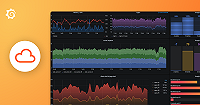Important: This documentation is about an older version. It's relevant only to the release noted, many of the features and functions have been updated or replaced. Please view the current version.
Receive profiles from Pyroscope SDKs
The pyroscope.receive_http component in Alloy receives profiles from applications instrumented with Pyroscope SDKs. This approach provides several benefits:
- Lower latency by sending profiles to a local Alloy instance instead of over internet
- Separation of infrastructure concerns (auth, routing) from application code
- Centralized management of authentication and metadata enrichment
For more information about this component, refer to the pyroscope.receive_http component documentation.
Note
The
pyroscope.receive_httpcomponent is currently in public preview. To use this component, set the--stability.levelflag topublic-preview. For more information about Alloy’s run usage, refer to the run command documentation documentation.
To set up profile receiving, you need to:
- Configure Alloy components
- Configure your application’s SDK
- Start Alloy
Configure Alloy components
The configuration requires at least two components:
pyroscope.receive_httpto receive profiles via HTTPpyroscope.writeto forward profiles to Pyroscope
Here’s a basic configuration that sets up a simple profile collection pipeline. It creates a receiver to collect profiles from your applications and forwards them through a writer component to send them to the Pyroscope backend:
// Receives profiles over HTTP
pyroscope.receive_http "default" {
http {
listen_address = "0.0.0.0"
listen_port = 9999
}
forward_to = [pyroscope.write.backend.receiver]
}
// Forwards profiles to Pyroscope
pyroscope.write "backend" {
endpoint {
url = "http://pyroscope:4040"
}
}Configure application SDK
Update your application’s SDK configuration to point to Alloy’s receive endpoint instead of Pyroscope directly. For example, in Go:
config := pyroscope.Config{
ApplicationName: "my.service.cpu",
ServerAddress: "http://localhost:9999", // Alloy's receive endpoint
}Check your specific language SDK documentation for the exact configuration options.
Examples
The examples in this section provide samples you can use as a starting point for your own configurations.
Basic receiving setup
This example shows a basic setup receiving profiles on port 9090 and forwarding them to a local Pyroscope instance:
pyroscope.receive_http "default" {
http {
listen_address = "0.0.0.0"
listen_port = 9090
}
forward_to = [pyroscope.write.backend.receiver]
}
pyroscope.write "production" {
endpoint {
url = "http://localhost:4040"
}
}Authentication
To send profiles to an authenticated Pyroscope endpoint:
pyroscope.write "production" {
endpoint {
url = "http://pyroscope:4040"
basic_auth {
username = env("PYROSCOPE_USERNAME")
password = env("PYROSCOPE_PASSWORD")
}
}
}Adding external labels
External labels are added to all profiles forwarded through the write component. This is useful for adding infrastructure metadata:
pyroscope.receive_http "default" {
http {
listen_address = "0.0.0.0"
listen_port = 9999
}
forward_to = [pyroscope.write.backend.receiver]
}
pyroscope.write "backend" {
endpoint {
url = "http://pyroscope:4040"
}
external_labels = {
"env" = "production",
"region" = "us-west-1",
"instance" = env("HOSTNAME"),
"cluster" = "main",
}
}Multiple destinations
Forward received profiles to multiple destinations - useful for testing or migration scenarios:
pyroscope.receive_http "default" {
http {
listen_address = "0.0.0.0"
listen_port = 9999
}
forward_to = [pyroscope.write.staging.receiver, pyroscope.write.production.receiver]
}
// Send profiles to staging
pyroscope.write "staging" {
endpoint {
url = "http://pyroscope-staging:4040"
}
external_labels = {
"env" = "staging",
}
}
// Send profiles to production
pyroscope.write "production" {
endpoint {
url = "http://pyroscope-production:4041"
}
external_labels = {
"env" = "production",
}
}Note
This configuration will duplicate the received profiles and send a copy to each configured
pyroscope.writecomponent.
Another approach is to configure multiple receivers with multiple destinations:
pyroscope.receive_http "staging" {
http {
listen_address = "0.0.0.0"
listen_port = 9998
}
forward_to = [pyroscope.write.staging.receiver]
}
pyroscope.receive_http "production" {
http {
listen_address = "0.0.0.0"
listen_port = 9999
}
forward_to = [pyroscope.write.production.receiver]
}
// Send profiles to staging
pyroscope.write "staging" {
endpoint {
url = "http://pyroscope-staging:4040"
}
external_labels = {
"env" = "staging",
}
}
// Send profiles to production
pyroscope.write "production" {
endpoint {
url = "http://pyroscope-production:4041"
}
external_labels = {
"env" = "production",
}
}For more information about component configuration options, refer to:
- pyroscope.receive_http documentation
- pyroscope.write documentation


